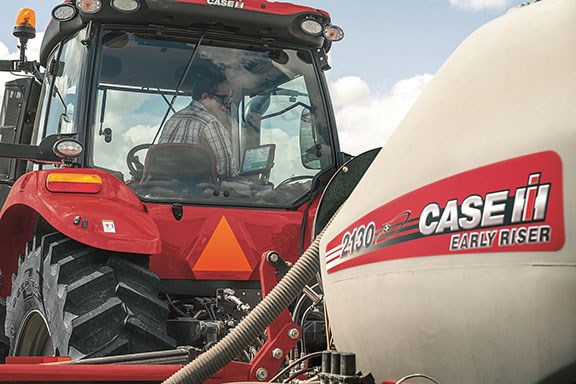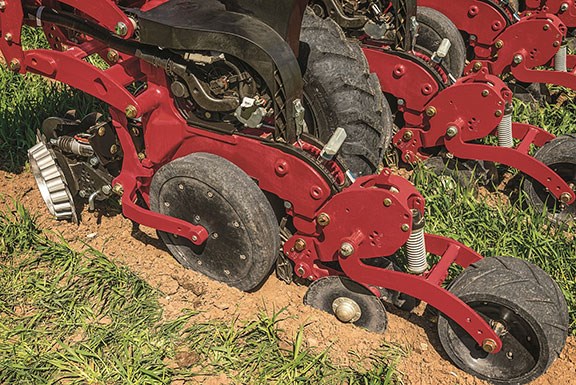We got a glimpse of the brand new Case IH Early Riser 2130 Stack-Fold Planter at its Australian product launch in Queensland
The focus for Case IH engineers in the United States, who spent about eight years developing this latest model, was on increased accuracy, with a flat bottom seed trench providing proper depth and more consistent seed placement, improved durability of its parts and better productivity — namely the speed at which farmers can plant their seed.
Case IH has partnered with leading agricultural technology company Precision Planting to make the Early Riser 2000 Series the only planter engineered and built with Precision Planting components direct from the factory.
Key among its features is the in-furrow liquid fertiliser delivery system, which helps to give each seed the best chance of successful growth.
“This is an exciting new offering and we’re proud to be able to present a design and technology package unmatched within the planter market,” Case IH product manager for planting and soil management equipment Andrew Kissel explains to the crowd keen to catch a glimpse of the newest planter on the Aussie market.
 |
|
The new Case IH Early Riser 2130 working with a Case IH Magnum 380
|
“We took the position that this planter needed to leave the factory with everything the customer needs for their operation. It needs to be the complete product on arrival, rather than having to make the initial purchase and incur the additional costs of technology add-ons.”
The Early Riser 2130 is already being used in the United States and a number of other markets around the globe, many of which have similar conditions to Australia. The planter will be initially introduced to local cotton growers, but there are far larger plans for the 2130 into the future.
“Summer crops like cotton and sorghum will be our primary market to start. We are looking at corn as well, with plans to start investigating alternative markets that we have seen positive agronomic results with in our trials,” Kissel says.
 |
|
The Early Riser 2130 is already being used in the United States
|
GREATER CONTROL
Anyone could see the huge step up in technology and design of the individual rows units on this ultra-modern 12-row seeder, especially since they had an example of its predecessor at the launch event for comparison.
No, that’s not a ‘ninja star’ at the front of the row unit; it’s the Floating Residue Management System, with Clean Sweep air cylinders that “allow for in cab adjustments of residue manager ride to accommodate soil and residue conditions”.
You can control everything via the Case IH AFS Pro 700 display in your tractor cabin; this computer allows you to run up to six screens at a time controlling all planter functions.
“The basic DNA is the same as the previous model, but we didn’t just want to make basic refinements to the last planter model, which we launched in Australia about five years ago,” Kissel says.
“We really did start with a blank slate and redesigned this from the ground up.
“We spoke to customers about what they wanted to see improved or modified and that really helped our engineers.
“One of the main things they wanted was more control and the placement of the seed to be more precise, even at higher speeds.”
Indeed, the discerning crop farmers in attendance did seem impressed after inspecting the planted rows in the earth once the planter roared into action and couldn’t fault the lines or seed placement.
“The thing that’s really critical is the way it puts seed in the ground, that is the reason it has earned the name Early Riser,” Kissel explains.
“The technology allows us to understand what’s happening and control the environment to some extent, but the row unit itself and its components – the steel, the rubber on the bottom end of the machine – that’s what really makes the difference.
“You will see faster emergence and more uniform germination in a wide variety of crops with the Early Riser planter, which has been proven time and again, and replicated in our agronomic trials.
“It starts with the rugged row unit that has a tried and tested design, combined with the factory integration of the industry’s best planter technologies.”
 |
|
The row unit on the Case IH early riser 2130 planter ensures faster emergence and more uniform germination in a wide variety of crops
|
IMPROVED DESIGN
The combination of some major and a huge number of seemingly minor design improvements add up to make a big difference in the final planting results in the field, according to Case IH.
“All of our gauge wheels now have a reduced inner diameter. This moves the weight of the row unit out and away from the centre of planter, which helps create a soup can-sized area around the seed uncompacted and that helps germination,” Kissel says.
“Also as the discs open that furrow and bring the soil up; it stored that soil in its ‘cheeks’ like a squirrel.
“By packing that soil up into these channels on the bottom of the machine, we don’t get as much compaction in the side wall.
“This is ideal because side wall compaction directly impacts germination and young plant vigour, because young plants can’t get through that crusted layer along the side walls of the trench and end up having roots that grow laterally instead of straight down.”
Configurations for the Case IH Early Riser 2130 Stack-Fold Planter include a 30ft (9.1m) toolbar (12-row, 30 inches [76.2cm]); 38ft (11.6m) toolbar (12-row, 36 inches [91.4cm] or 12-row, 38 inches [96.5cm]); and 40ft (12.2m) toolbar (12-row, 40 inches [101.6cm] or 16-row, 30 inches [76.2cm]).
A number of demonstration events are planned for New South Wales, Western Australia and other parts of Queensland in the months ahead.
Features include:
- Opening and closing systems improved for difficult soils and tough conditions;
- More vertical travel for improved ground following and consistent planting depth in severe terrain;
- Speed and productivity without sacrificing accuracy;
- Row by row planting with DeltaForce and vDrive. Row by row shut-off of seed, insecticide, and fertiliser;
- Easy connectivity of the optional 20/20 SeedSense, FieldView, and iPad connectivity kit;
- Simplified serviceability and maintenance;
- Liquid fertiliser and insecticide options.


